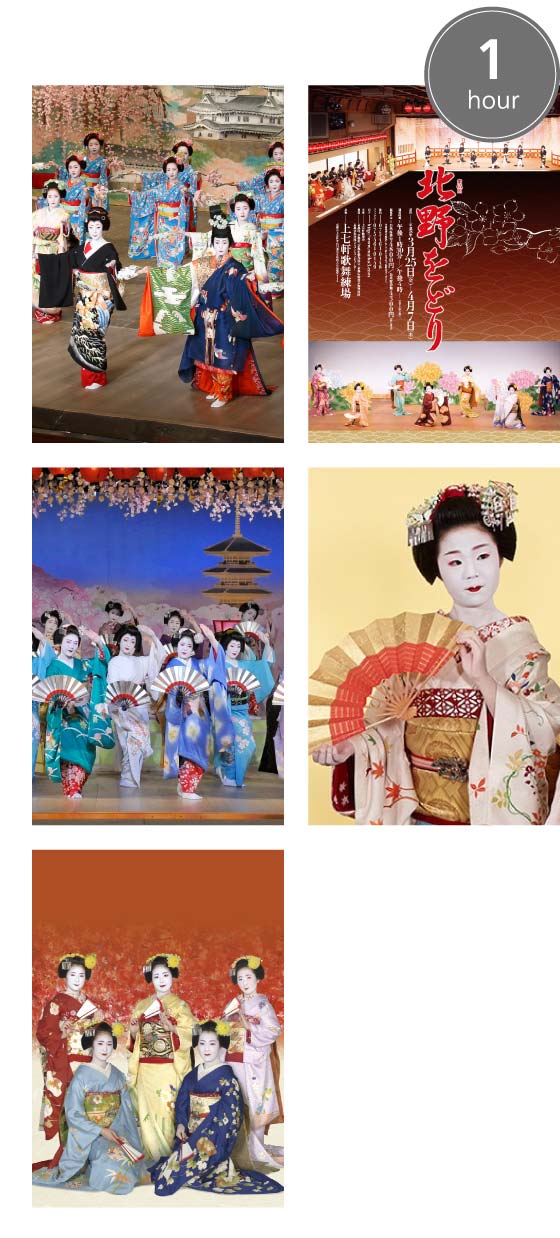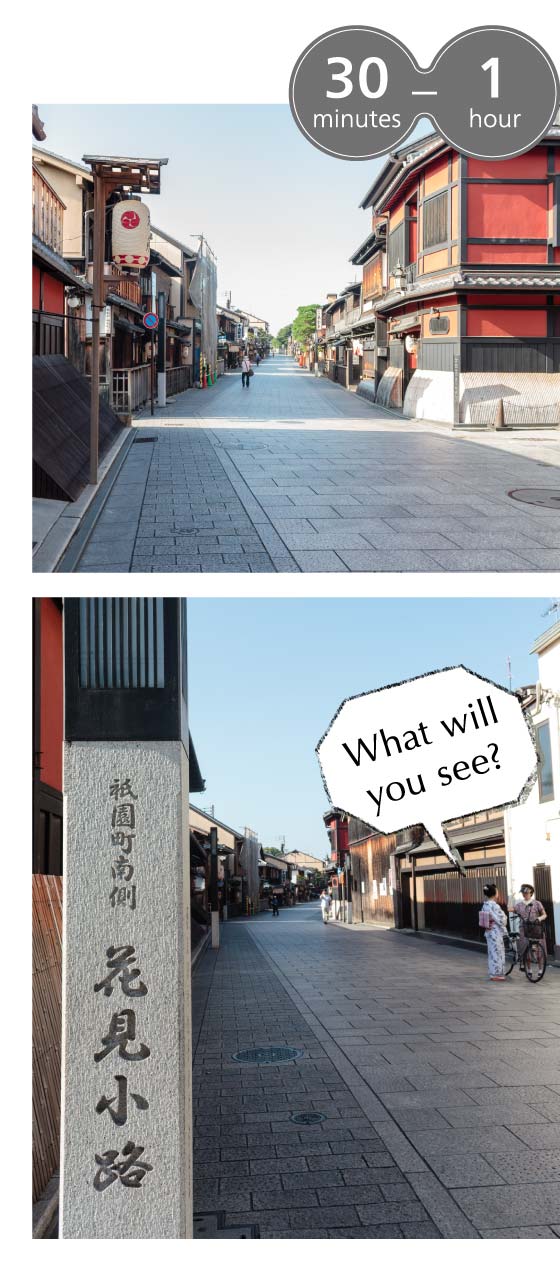When people think “Kyoto” they also think “geisha”- and for good reason. Home to five different hanamachi (“flower towns”, districts) each with its own distinct history, style, and traditions within a highly ritualized world, Kyoto is proud to have the strongest remaining geisha community in Japan, where the word “geiko” is used to refer to these talented women. Whether it’s enjoying a banquet, attending annual public dance performances, or exploring the neighborhoods these amazing artists call home, this itinerary is for those interested in taking a step into the “flower and willow world”.



 Gion Shirakawa Street, Gion Higashi District
Gion Shirakawa Street, Gion Higashi District
No matter what they say, / I love Gion. / Even in my sleep / The sound of water / Flows beneath my pillow
OPENING HOURS
Public street and shrine open 24 hours, respective businesses’ hours vary.
NEAREST STATION / BUS STOP
Gion Shirakawa Bus Stop ⇒ 5 minutes walking from Sanjō Keihan and Gion Shijō on the Keihan Line
ALSO IN THE AREA


 Yasaka Shrine
Yasaka Shrine
Winding through Gion Higashi district and back to the main Shijō Street will put you on track to the main shrine in the Gion area: Yasaka Shrine. With an approach lined with countless shops and restaurants catering to tourists containing a variety of modern and traditional items and foods, doing some shopping is hard to resist. At the end of Shijō Street is the shrine itself, with its signature vermilion gate beckoning visitors inside to explore its grounds and the connected Maruyama Park. Connected as it is to the nearby geisha districts, this shrine’s festivals often feature geisha performances, and it’s said geiko and maiko sometimes visit the Utsukushii Gozen-sha sub-shrine on the property which is famous for its power over beauty.
OPENING HOURS
Shrine open 24 hours, shrine offices manned from 09:00 until 17:00.
NEAREST STATION / BUS STOP
Gion Bus Stop ⇒ 5 minutes walking from Gion Shijō on the Keihan Line
ALSO IN THE AREA



 Kennin-ji
Kennin-ji
Potentially the oldest Zen temple in Kyoto, Kennin-ji lies right between the Gion Kōbu and Miyagawa-chō districts. Take a quick break from the bustling tourist streets and teahouses to enjoy the quiet atmosphere of Zen, including the temple’s lovely gardens and the dramatic ink painting of giant dragons on the ceiling of the main hall.
OPENING HOURS
10:00 – 17:00 (March – October), 10:00 – 16:30 (November – February)
NEAREST STATION / BUS STOP
By Keihan Line Train ⇒ Gion Shijō Station ⇒10 minutes walking
By Hankyū Line Train ⇒ Kyoto Kawaramachi Station ⇒ 10 minutes walking
By City Bus ⇒ Bus Route 206, 100 ⇒ Higashiyama Yasui, Minamiza-mae, or Gion Bus Stop ⇒ 5-10 minutes walking
ALSO IN THE AREA


OPTION: Public Dance Performance
Each geisha district in Kyoto hosts an annual public dance performance that allows visitors to enjoy a sampling of the districts’ repertoire and the skill of their geiko and maiko. If you’re traveling in Kyoto in April you may be able to attend Gion Kōbu’s month-long Miyako Odori, Miyagawa-chō’s Kyo Odori in the first half of the month, or Kamishichiken’s Kitano Odori. In early May, there is Ponto-chō’s Kamogawa Odori, and in early November you have the chance to see Gion Higashi’s Gion Odori. The easiest way for tourists to reserve tickets is through the Tourist Information Center in Kyoto Station, but they can also be bought on the day at the theater if still available.
OPENING HOURS
Varies by dance, usually two performances offered daily in the afternoon.
NEAREST STATION / BUS STOP
Varies by dance, check for the kaburenjō location in each district.



 Hanami-kōji Area
Hanami-kōji Area
The largest district in Kyoto is Gion Kōbu, and thanks to its prime location in the heart of Gion, it’s also the most visited by tourists. One of the things most visitors really want to see is a real life geiko or maiko, not another tourist dressed up for the day. In the late afternoon and early evening is prime time to catch sight of one of these amazing artists on their way to work at one of Gion Kōbu’s illustrious teahouses, where only those elite few with the right connections can be entertained. However, while we understand how exciting it can be to catch sight of what you admire, we ask everyone to remember to be respectful and not interfere with or stop the geiko and maiko’s activities as they are on their way to work.
OPENING HOURS
“Prime time” to see geiko and maiko on their way to work is around 6 pm.
NEAREST STATION / BUS STOP
Hanami-kōji Bus Stop, Gion Shijō Station on the Keihan Line, Kyoto Kawaramachi Station on the Hankyū Line
ALSO IN THE AREA



 Nightlife in Ponto-chō
Nightlife in Ponto-chō
Ponto-chō district is composed of a single narrow street extending along the Kamogawa River across the bridge from Gion. This unassuming area comes to life at night as the small restaurants, teahouses, and bars that comprise the district light up and open their doors, making it the perfect place to end your night soaking in the atmosphere and enjoying a few drinks. Try to get a seat in a narrow local bar that only sits five, or find a more spacious restaurant to enjoy yourself at. If you’re lucky you may catch sight of one of Ponto-chō’s hardworking artisans walking down the street or accompanying a patron into an establishment, a perfect way to end your night.
OPENING HOURS
Many bars are open until the AM hours, but last trains are between 11:30 and 12:00 - check your local trains.
NEAREST STATION / BUS STOP
Sanjo Keihan Station, Kyotoshiyakusho-mae Station, Kyoto Kawaramachi Station, Gion Shijo Station
ALSO IN THE AREA
 Kyoto Takashimaya Department Store
Kyoto Takashimaya Department Store Shijo Bridge
Shijo Bridge Kyoto Minami-za Theatre
Kyoto Minami-za Theatre Pontocho Kaburenjo Theater
Pontocho Kaburenjo Theater

